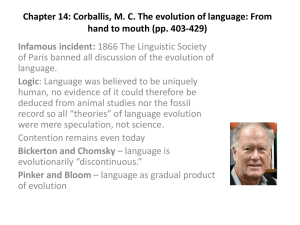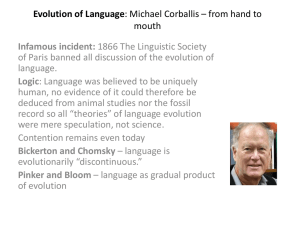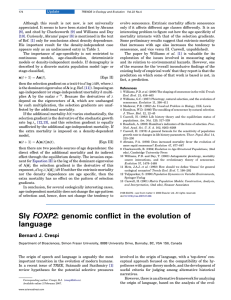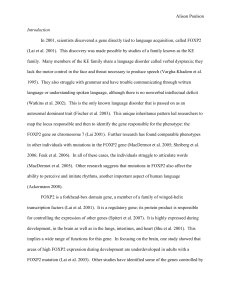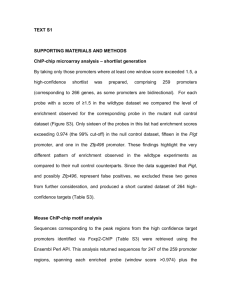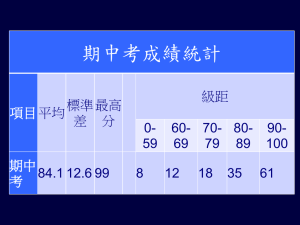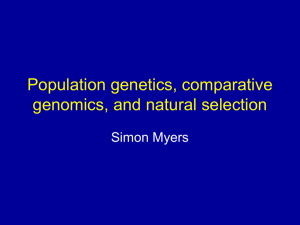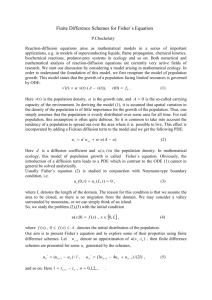Works Cited Ackermann H. Cerebellar contributions to speech
advertisement
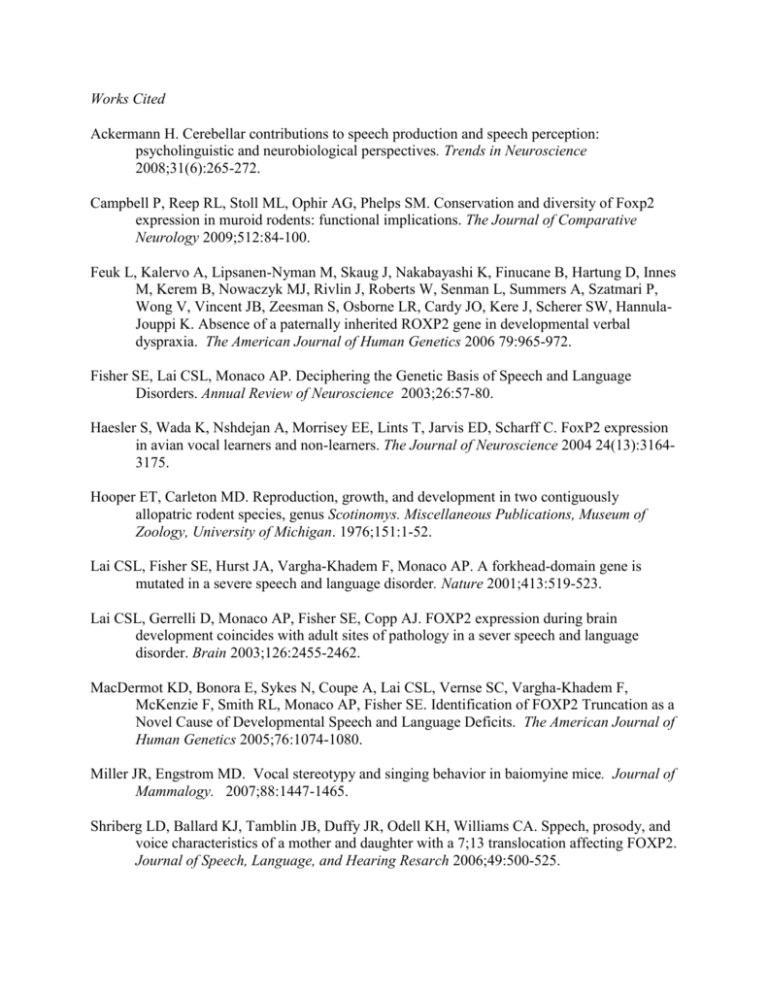
Works Cited Ackermann H. Cerebellar contributions to speech production and speech perception: psycholinguistic and neurobiological perspectives. Trends in Neuroscience 2008;31(6):265-272. Campbell P, Reep RL, Stoll ML, Ophir AG, Phelps SM. Conservation and diversity of Foxp2 expression in muroid rodents: functional implications. The Journal of Comparative Neurology 2009;512:84-100. Feuk L, Kalervo A, Lipsanen-Nyman M, Skaug J, Nakabayashi K, Finucane B, Hartung D, Innes M, Kerem B, Nowaczyk MJ, Rivlin J, Roberts W, Senman L, Summers A, Szatmari P, Wong V, Vincent JB, Zeesman S, Osborne LR, Cardy JO, Kere J, Scherer SW, HannulaJouppi K. Absence of a paternally inherited ROXP2 gene in developmental verbal dyspraxia. The American Journal of Human Genetics 2006 79:965-972. Fisher SE, Lai CSL, Monaco AP. Deciphering the Genetic Basis of Speech and Language Disorders. Annual Review of Neuroscience 2003;26:57-80. Haesler S, Wada K, Nshdejan A, Morrisey EE, Lints T, Jarvis ED, Scharff C. FoxP2 expression in avian vocal learners and non-learners. The Journal of Neuroscience 2004 24(13):31643175. Hooper ET, Carleton MD. Reproduction, growth, and development in two contiguously allopatric rodent species, genus Scotinomys. Miscellaneous Publications, Museum of Zoology, University of Michigan. 1976;151:1-52. Lai CSL, Fisher SE, Hurst JA, Vargha-Khadem F, Monaco AP. A forkhead-domain gene is mutated in a severe speech and language disorder. Nature 2001;413:519-523. Lai CSL, Gerrelli D, Monaco AP, Fisher SE, Copp AJ. FOXP2 expression during brain development coincides with adult sites of pathology in a sever speech and language disorder. Brain 2003;126:2455-2462. MacDermot KD, Bonora E, Sykes N, Coupe A, Lai CSL, Vernse SC, Vargha-Khadem F, McKenzie F, Smith RL, Monaco AP, Fisher SE. Identification of FOXP2 Truncation as a Novel Cause of Developmental Speech and Language Deficits. The American Journal of Human Genetics 2005;76:1074-1080. Miller JR, Engstrom MD. Vocal stereotypy and singing behavior in baiomyine mice. Journal of Mammalogy. 2007;88:1447-1465. Shriberg LD, Ballard KJ, Tamblin JB, Duffy JR, Odell KH, Williams CA. Sppech, prosody, and voice characteristics of a mother and daughter with a 7;13 translocation affecting FOXP2. Journal of Speech, Language, and Hearing Resarch 2006;49:500-525. Shu W, Cho JY, Jian Y, Zhang M, Weisz D, Elder GA, Schmeidler J, De Gasperi R, Sosa MAG, Rabidou D, Santucci AC, Perl D, Morrisey E, Buxbaum JD, Palese P. Proceedings of the National Academy of Sciences of the United States of America. 2005;102(27):9643-9648. Shu W, Yang H, Zhan L, Lu MM, Morrisey EE. Characterization of a new subfamily of wingedhelix/forkhead (Fox) genes that are expressed in the lung and act as transcriptional repressors. Jornal of Biological Chemistry 2001;276(27):488-497. Spiteri E, Konopka G, Coppola G, Bomar J, Oldham M, Ou J, Vernes SC, Fisher SE, Ren B, Geschwind DH. Identification of the transcriptional targets of ROXP2, a gene linked to speech and language, in developing human brain. The American Journal of Human Genetics 2007;81:1144-1157. Teramitsu I, Kudo LC, London SE, Geschwind DH, White SA. Parallel FoxP1 and FoxP2 expression songbird and human brain predicts functional interaction. The Journal of Neuroscience 2004;24(13):3152-3163. Vargha-Khadem F, Watkins K, Alcock K, Fletcher P, Passingham R. Praxic and nonverbal cognitive deficits in a large family with a genetically transmitted speech and language disorder. Proceedings of the National Academy of Science of the United States of America 1995;92:930-933. Vernes SJ, Spiteri E, Nicod J, Groszer M, Taylor JM, Davies KE, Geschwind DH, Fisher SE. High-throughput analysis of promoter occupancy reveals direct neural targets of FOXP2, a gene mutated in speech and language disorders. The American Journal of Human Genetics 2007;81:1232-1250. Watkins KE, Dronkers NF, Vargha-Khadem F. Behavioural analysis of an inherited speech and language disorder: comparison with acquired aphasia. Brain. 2002;125:452-464.

